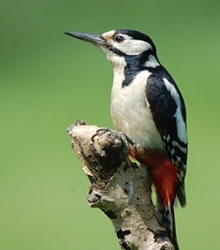Great spotted woodpecker (Dendrocopos major)
 February is an excellent month for hearing great spotted woodpeckers “drumming” – rapidly pecking on a resonant object to create a loud sound. Most often the chosen drum is a dead piece of wood among the trees.
February is an excellent month for hearing great spotted woodpeckers “drumming” – rapidly pecking on a resonant object to create a loud sound. Most often the chosen drum is a dead piece of wood among the trees.
However, woodpeckers may sometimes choose telegraph poles, house boardings or metal work such as chimney covers for drumming purposes. Quite often during the spring months, articles will appear in the press of a particular woodpecker that has found a resoundingly good object to drum on and manages to wake the whole neighbourhood early every morning!
It is the male that does most of the drumming as he is telling other woodpeckers that this is his territory and to stay away, while also communicating with females to let them know that he is ready and waiting, just as most birds do through song.
As the spring progresses and the females get nearer to mating, they will start reply drumming to the males. The male can drum at an unbelievably quick rate of up to 40 strikes per second, although a more relaxed 10 or 15 is more usual. The impact of this is equivalent to hitting a wall face first at up to 20 miles an hour and the sound can be easily heard up to half a mile away. To enable the bird to do this without getting constantly concussed, it has a specially-shaped hinge between the front of skull and beak, combined with a shock-absorbing muscle, which protects the bird's brain from the vibration.
The pied woodpecker, as it was often called in past days, is our most common woodpecker with around 40,000 pairs breeding in the UK and is about the size of a Blackbird. The male has a distinctive red patch on the back of the head which distinguishes it from the female which is just black and white. They are distributed over a wide range covering almost the entire Palearctic from Britain in the west to Japan in the east and reaching North Africa and the Canary Islands in the south-west.
We most often see them tucking into nuts on our bird feeders, but in the wild they are fairly omnivorous, eating a wide range of food. Difficult nuts and awkward pinecones are placed in clefts and hammered open with the bill. Particular trees are selected and the remains of food may be found scattered below these "anvil" trees. Great spotted woodpeckers will regularly attack wooden nest-boxes, enlarging the hole to gain access to the chicks of the tit family or nuthatches.
They will attack natural nest sites too and because their numbers have increased of late, are considered by some ornithologists to have played a part in the decline of the willow tit, which excavates its own nest hole in very soft dead wood, making it an easy target for Woodpeckers to eat. Certain individual great spotted woodpeckers have even been known to raid house martin colonies on houses, destroying many nests at a time.
Great spotted woodpeckers have stiffened, pointed tail feathers which serve as a prop to aid stability as they clamber up trunks or along branches, but, unlike nuthatches, they have great difficulty in travelling downwards, and can very occasionally be seen attempting the manoeuvre in a series of awkward, ungainly and rather comical backward hops. So, although the design of this bird is amazing in so many ways, it still has a little evolving to work on!!
Peter Thompson
Advisory

Download Peter Thompson's essential 26-page book, featuring beautiful photography and detailed profiles of Britain's wildlife
Download FREE >